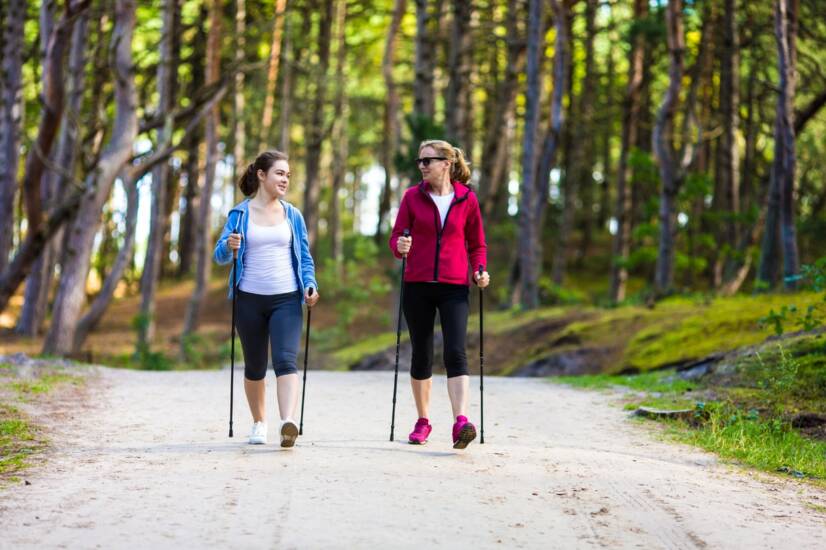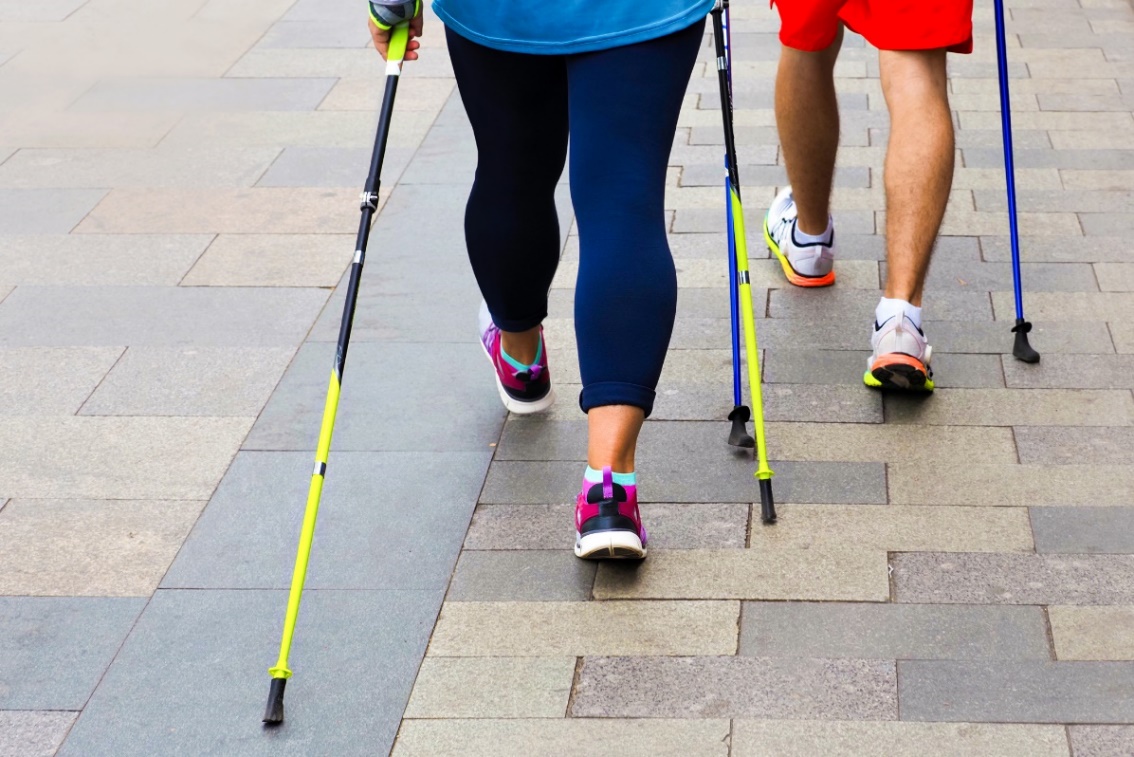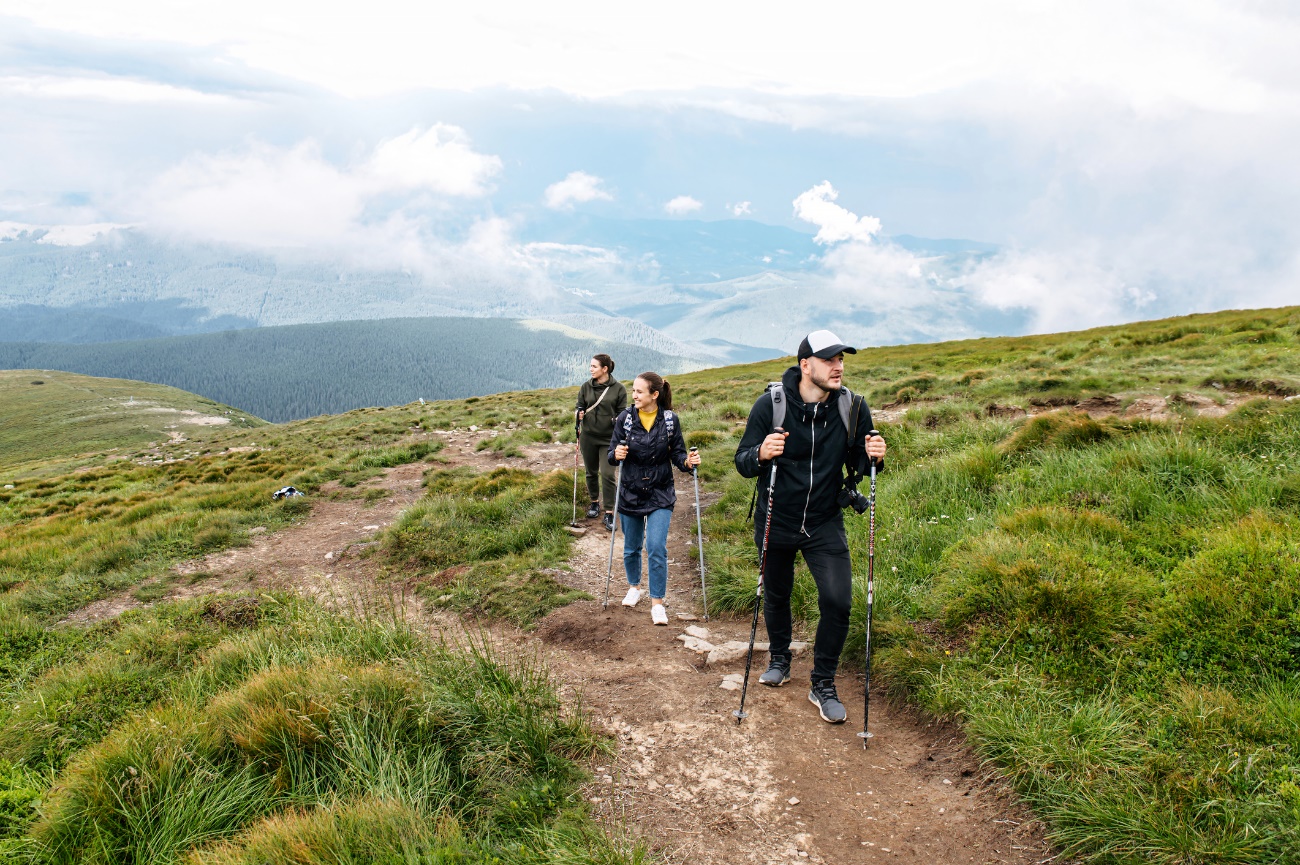- snwa.sk - HEALTH AND NORDIC WALKING
- nordicwalkingcouncil.com - International Council of Nordic Walking
- pubmed.ncbi.nlm.nih.gov - Health benefits of Nordic walking: a systematic review. Marcus Tschentscher, David Niederseer, Josef Niebauer
- is.muni.cz - Nordic Walking as a form of active holiday. Bachelor thesis. Jan Kyzlink, Thesis supervisor: Ing. Mgr. Jana Juříková, Ph.D. Masaryk University. Department of Kinesiology
- Youtube - Slovak Nordic Walking Association
Nordic walking: Nordic walking for health? Learn about the effects and suitable equipment

Nordic walking is a physical activity known as Nordic walking. It is walking with a specific technique using sticks. It is a sporting and regenerative activity that is recommended at any age. What are its benefits and importance for the human body?
Article content
Nordic walking
Nordic walking was first mentioned in 1988 in Finland by Tuomo Jantune, who organised a snow cross race. The snow had melted before the race, so the organiser proposed a race with poles but without cross-country skis.
In addition to the Nordic countries, Nordic walking initially developed in the USA.
Today, Nordic walking is an internationally used physical activity for health.
It is suitable for people of all ages, from children to the elderly.
The main feature of this specific walking activity is the use of special poles and upper body involvement.
Nordic walking is a dynamic, energetic type of walking that reduces the load on the joints and balances musculoskeletal imbalances.
The activity is performed outdoors in the fresh air, improves oxygenation of the body, promotes mental well-being and psychological health of the individual.
Walking for health
Walking on two limbs is the basic locomotor movement of a person, in which most of the muscular apparatus is involved.
According to studies, walking with sticks engages up to 90% of the muscles of the whole body. It increases energy expenditure (kcal), improves energy metabolism, promotes blood and lymph circulation and heart rate.
Nordic walking is based on the knowledge that engaging the upper limbs in walking reduces the demands and stress on the joints of the lower limbs. In particular, the demands on the knee and hip joints are reduced. Diaphragmatic breathing is activated and the deep stabilising muscles of the body are engaged.
Effects of Nordic walking:
- Activation of the muscles of the whole body
- Reduction of tension in the hip flexors of the lower limbs
- Stimulation of the cardiovascular system
- Increasing heart rate
- Support energy metabolism
- Support weight loss
- Removing muscle imbalances in the neck to chest area
- Improving breathing
- Beneficial effect on mental health
- Development of the social aspect
Nordic walking poles
Using the poles while walking results in intense hand activity, strengthens the internal muscles of the spine and balances muscle imbalances in the neck, shoulders and chest.
Along with rhythmic diaphragmatic breathing, the deep stabilisation system of the spine is strengthened.
With proper NW technique, lung function and function is stimulated.
How to choose the right clubs?
The original sticks designed for Nordic walking are height-adjustable, cushioned and with a stable soft grip.
They are finished with a metal tip and a removable rubber end handle for different surfaces. It is ideal to get poles with the above features.
The height of the sticks plays a big role. If inaccurately elevated, it can cause improper walking technique and activation of the wrong muscle groups of the musculoskeletal system.
The height of the sticks should be up to waist height, i.e. approximately 65% of the person's height. The height can be calculated accurately by multiplying the body height by 0.68.
Example: 170 cm x 0.68 = 115 cm long canes. The result is rounded to the nearest 5 cm.
The technique of holding the sticks is also important. The cloth loop is placed on the wrist in a stable enough way, but in such a way that it does not strangle. It serves to work the upper limbs dynamically without fear of the stick falling out of the hand when walking.
Suitable footwear and clothing
Good quality outdoor sports footwear is required for Nordic walking.
Soft, cushioned soles, waterproofing and stability are important. The back of the shoe must be sufficiently cushioned as it is the most stressed part of the foot during the impact phase of the stride.
The waterproof and slip-resistant function of the shoe is also important. For more demanding terrain, more stable hiking shoes with a slip-resistant sole and slight ankle fixation are suitable.
The choice of clothing always depends on the outdoor conditions and the weather. However, it is important to bear in mind the possibility of overheating on warm days and hypothermia in winter.
The so-called onion style of dressing is often used, which consists of several easily removable layers.
The first layer tends to be functional underwear or thermal underwear, which is designed to wick sweat away from the body's surface. A material that feels comfortable on the body is important.
The second or third layer of clothing is designed to protect the body from adverse weather conditions such as rain, snow or wind. On cold days, special attention should be paid to the exposed Achilles tendons, lower back, larynx and sinuses.

Correct Nordic walking technique
In Nordic walking there is no flight phase of the stride. One foot is always firmly on the mat, thus saving the joints of the lower limbs.
It is important to place the whole foot on the ground. In the stride phase, the heel comes first and then the front of the foot. In the peel-off phase, the order is the same - the back of the foot comes first and then the toes.
The steps in Nordic walking are slightly longer and more vigorous than in normal walking.
There is slightly more counter-rotation of the pelvis and shoulders (contralateral rotation of the trunk) than in normal walking. Nordic walking emphasises correct, rhythmic and regular breathing.
In particular, the diaphragm, intercostal muscles and transverse abdominis should be involved in breathing. It is the diaphragmatic breathing that is important for activating and stabilising the body.
The balanced movement of the arms, legs and trunk engages both cerebral hemispheres and thus promotes the development of brain activity.
The toe of the stick is driven in at the level of the heel of the forefoot. The toe of the stick is driven in with the opposite upper limb.
At the same time, the other upper limb is hooked, extended at the elbow and completes the unhooking of the other stick. It should be remembered that this is not a conventional walking with sticks, but a mutual dynamic rhythmic movement of the body and sticks.
The technique may seem complicated at first sight, but after explanation and demonstration people can easily understand it.
For better understanding, instruction by a trained therapist or Nordic walking coach is recommended.
The most common mistakes in Nordic walking:
- Disorder of opposing movement of the upper and lower limbs
- Incorrect posture
- Forward posture of the head and shoulders
- Lifting of shoulders and trapezius muscles
- Excessive spasticity of the sticks
- Forgetting to bounce the clubs with the back hand
- Failure to use clubs when walking
- Irregular breathing
- Failure to activate the diaphragm and diaphragmatic breathing
- Exaggerated knee extension during squatting
- Improper footfalls
- Hands and sticks too far away from the body
Indications and contraindications
Nordic walking has very few contraindications and is known to be suitable for a variety of ages and medical diagnoses.
Nordic walking is a suitable activity for children and pregnant women.
This outdoor recreational activity is also commonly performed in groups in rehabilitation institutes and spa centres. It leads to the development of the social and communication area of the individual. On the other hand, after training, it is possible to walk independently in harmony with nature.
Example of indications for Nordic walking:
- Diabetes mellitus
- Obesity and overweight
- Cardiovascular diseases of lower degrees
- Respiratory diseases in the lower stages
- Osteoporosis
- Osteoarthritis
- Musculoskeletal imbalances
- Neuromuscular coordination disorders
- Weakening of the musculoskeletal system
- Parkinson's disease
- Alzheimer's disease
- Defective posture
- Vertebroalgia syndrome
- Post-operative conditions
- Anxiety and depression
Contraindications to NW
There are quite a few reasons why Nordic walking is not possible.
These include high stages of cardiovascular and respiratory disease, inability to walk on two limbs, inability to engage the upper limbs, current viral and inflammatory disease, elevated temperature, general cachexia (weakness, emaciation), possible cancer, and others.
If in doubt about the suitability of Nordic walking, consultation with a physician or physiotherapist is recommended.
Advanced variants of Nordic walking
Nordic running is running with the help of NW poles. It is a running technique involving the upper body. Nordic running is more demanding on the cardiovascular system and the individual's musculoskeletal system. It is suitable as a regenerative form of leisure activity or a compensatory activity for athletes.
Off-road walking is a more strenuous type of walking in more challenging terrain. It is an advanced fitness and strength variant of Nordic walking. Due to the type of environment and terrain, it also uses stepping and flight phases of the stride. There is a greater load on the musculoskeletal and cardiovascular system.
Nordic blading is roller skating using the NW stick technique. This variant is a particularly enjoyable form of restorative physical activity for those more technically proficient in skating. However, there is an increased risk of falling and, with incorrect technique, a risk of exacerbating musculoskeletal imbalances.

Interesting resources










